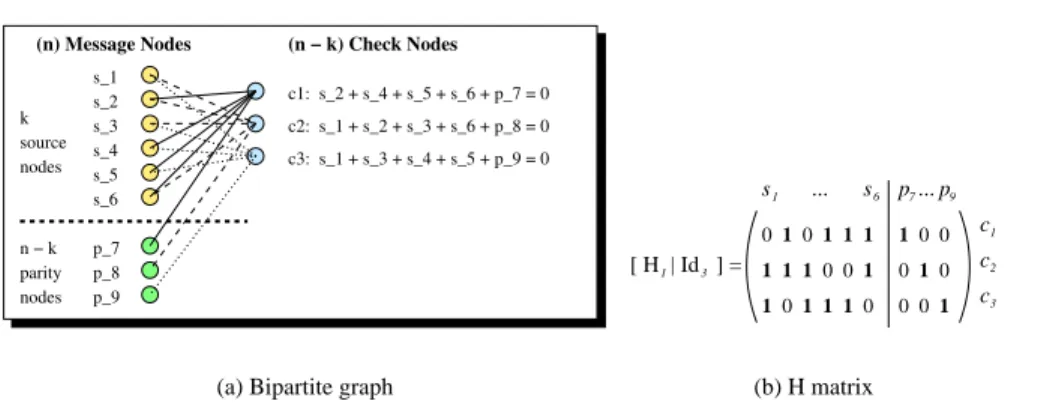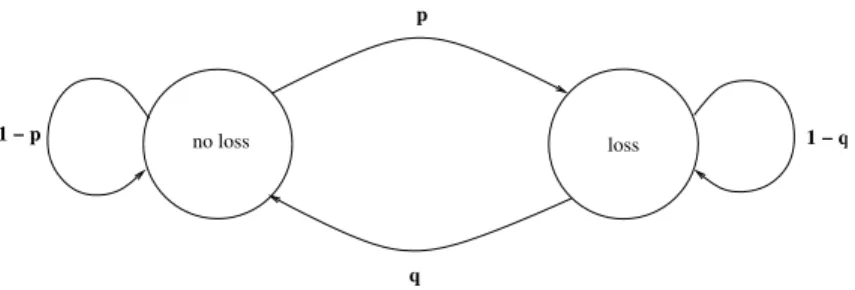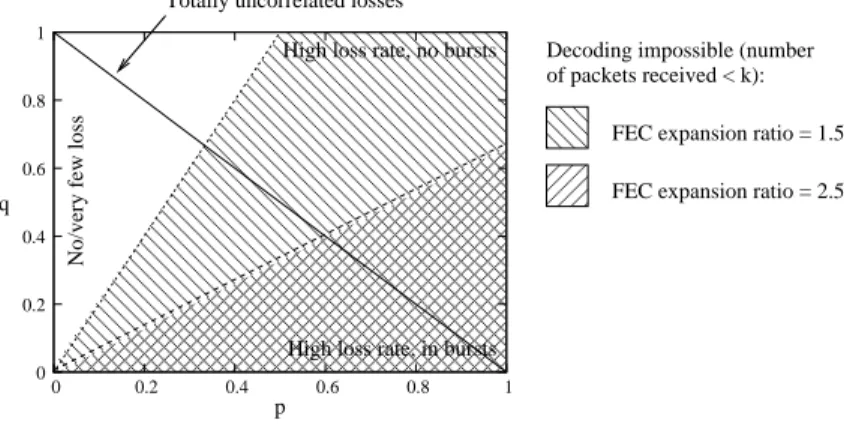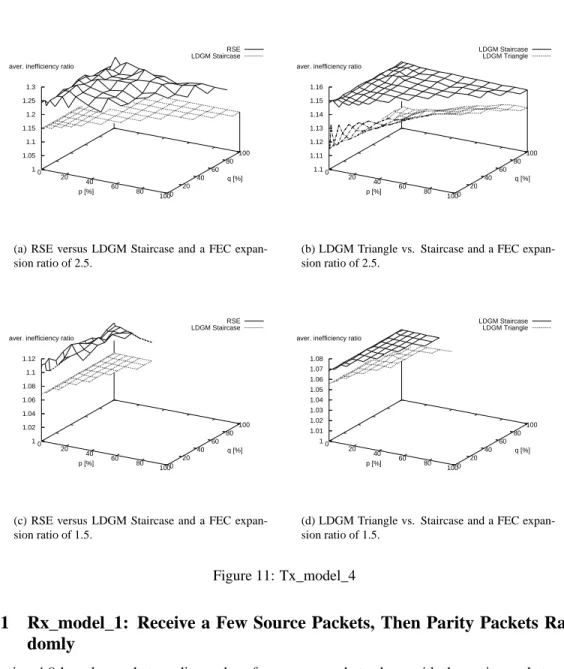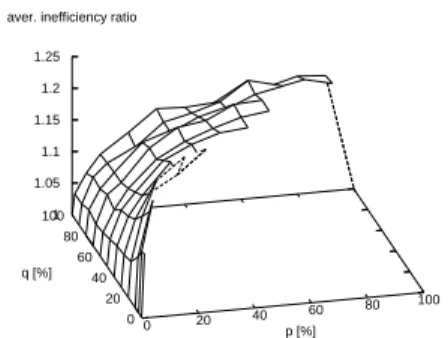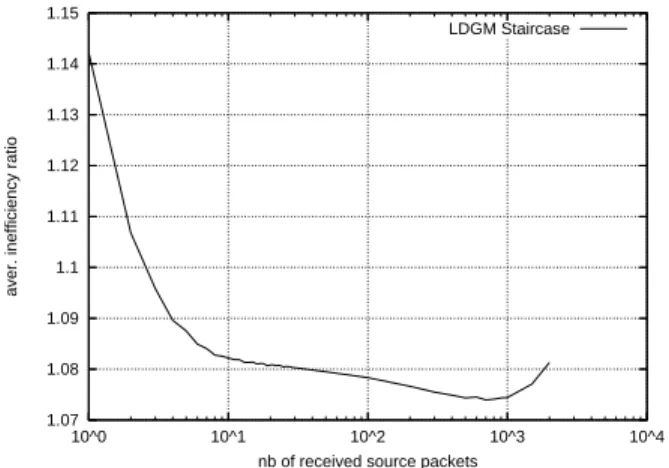HAL Id: inria-00000146
https://hal.inria.fr/inria-00000146
Submitted on 7 Jul 2005
HAL is a multi-disciplinary open access
archive for the deposit and dissemination of
sci-L’archive ouverte pluridisciplinaire HAL, est
destinée au dépôt et à la diffusion de documents
Distribution on FEC Performances: Observations and
Recommendations
Christoph Neumann, Vincent Roca, Aurelien Francillon, David Furodet
To cite this version:
Christoph Neumann, Vincent Roca, Aurelien Francillon, David Furodet. Impacts of Packet Scheduling
and Packet Loss Distribution on FEC Performances: Observations and Recommendations. [Research
Report] RR-5578, INRIA. 2005, pp.29. �inria-00000146�
a p p o r t
d e r e c h e r c h e
THÈME 1
Impacts of Packet Scheduling and Packet Loss
Distribution on FEC Performances: Observations
and Recommendations
Christoph NEUMANN
(1)
— Vincent ROCA
(1)
— Aurélien FRANCILLON
(1)
—
David FURODET
(2)
(1)
INRIA Rhône-Alpes, Planète Research Team - {firstname.name}@inrialpes.fr
(2)
STMicroelectronics, AST, Grenoble, France - david.furodet@st.com
N° 5578
Christoph NEUMANN
(1)
, Vincent ROCA
(1)
, Aurélien FRANCILLON
(1)
,
David FURODET
(2)
(1)
INRIA Rhône-Alpes, Planète Research Team - {firstname.name}@inrialpes.fr
(2)
STMicroelectronics, AST, Grenoble, France - david.furodet@st.com
Thème 1 — Réseaux et systèmes
Projet Planete
Rapport de recherche n° 5578 — Mai 2005 — 29 pages
Abstract: Forward Error Correction (FEC) is commonly used for content broadcasting. The
perfor-mance of the FEC codes largely vary, depending in particular on the object size and on the number of
parity packets produced, and these parameters have already been studied in detail by the community.
However the FEC performances are also largely dependent on the packet scheduling used during
transmission and on the loss pattern introduced by the channel. Therefore this work analyzes their
impacts on three FEC codes: LDGM Staircase, LDGM Triangle, two large block FEC codes, and
Reed-Solomon. Thanks to this analysis, we define several recommendations on how to best use these
codes, depending on the test case and on the channel, which turns out to be of utmost importance.
Key-words:
Multicast, Forward Error Correction (FEC), LDPC, Reed-Solomon, Loss Pattern,
Packet Scheduling
des Pertes de Paquets sur les Performances de trois Codes
Correcteurs d’Erreurs: Observations et Recommandations
Résumé : Les codes correcteurs d’erreurs (ou FEC, “Forward Error Correction”) sont largement
utillisés dans le contexte de la diffusion à large échelle de contenus. Les performances de ces codes
FEC dépendent fortement de la taille de l’objet encodé et du nombre de paquets de parité produits.
Ces deux paramètres ont déjà été étudiés en détails par la communauté. Toutefois les performances
dépendent aussi fortement de l’ordonnancement des paquets utilisé lors de la transmission ainsi que
de la distribution des pertes sur le canal de transmission. Par conséquent, ce travail analyse les
impacts de ces paramètres sur trois codes : LDGM Staircase et LDGM Triangle, deux codes FEC de
type grands blocs, et Reed-Solomon. Grace à cette analyse, nous établissons des recommandations
d’une très grande importance pratique pour une utilisation optimale de ces codes en fonction du
canal de transmission et du scénario d’utilisation.
Mots-clés : Multicast, Codes Correcteurs d’Erreurs, LDPC, Reed-Solomon, Distribution des Pertes
1
Introduction
1.1
Context of the work
This work analyzes the impacts of packet scheduling in the context of a content delivery systems like
”IP Datacast” (IPDC) [12, 6] in DVB-H, the ”Multimedia Broadcast/Multicast Service” (MBMS) [1]
in 3GPP, or data broadcast to cars (e.g. [5]). These systems are characterized by the fact that there
is no back channel, and therefore no repeat request mechanism can be used that would enable the
source to adapt its transmission according to the feedback information sent by the receiver(s). The
lack of feedback channel however enables an unlimited scalability in terms of number of receivers,
who behave in a completely asynchronous way. Using a reliable multicast transmission protocol like
ALC [9], along with the FLUTE [13] file delivery application, can turn out to be highly effective in
this context [5].
Yet, in order to be efficient, these approaches largely rely on the use of a Forward Error
Correc-tion (FEC) scheme running at the applicaCorrec-tion layer, within the ALC reliable transport protocol (we
motivate the use of FEC in section 4.2). The channel is therefore a “packet erasure channel” and
packets either arrive (with no error) or are lost (e.g. because of router congestion problems). After
an FEC encoding of the content, redundant data is transmitted along with the original data. Thanks
to this redundancy, up to a certain number of missing packets can be recovered at the receiver. The
great advantage of using FEC with multicast or broadcast transmissions is that the same parity packet
can recover different lost packets at different receivers.
Since we only consider file delivery applications in this work, the transmission latency has little
importance, which would not be true with streaming applications. Therefore we will not consider
the potential impacts of FEC codes and transmission scheme on the decoding latency at a receiver.
1.2
Goals of the work
The performance of the FEC code is largely impacted by the transmission scheduling. For instance,
sending all source packets first and then parity packets does not necessarily yield the same efficiency
as sending the packets in random order. The packet loss distribution observed by a receiver also
largely impact the decoding performances and a given transmission scheme may yield good results
for a specific loss distribution and yield catastrophic results in other circumstances. This work
ana-lyzes the impacts of packet scheduling and loss behaviors on the performances of three FEC codes:
Reed-Solomon, LDGM Staircase and LDGM Triangle. Thanks to this analysis, we define several
recommendations on how to best use these codes, which turns out to be of utmost practical
impor-tance. For instance it enables to optimize the FLUTE session to a specific download environment, or
on the opposite, to find transmission schemes that will behave correctly (but may be not optimally)
in a wide set of different environments.
In this work we do not considered FEC codes who are known to be covered by IPRs and for
which no public domain, open-source, implementation exists. In particular we will not consider
Tornado™ and Raptor™ codes [4]. This deliberate choice is likely to enlarge the usefulness of our
results to a large part of the community who prefer free codes.
The remainder of the paper is organized as follows: we first introduce the three FEC codes;
section 3 explains and motivates the modeling method we used; section 4 presents and analyzes the
performance of several transmission schemes while section 5 does the same with a reception model;
finally section 6 explains how to use these results in practice, then we conclude.
2
Introduction to RSE, LDGM Staircase and LDGM Triangle
Codes
2.1
Terminology
FEC encoding of an object produces redundant data. Thanks to this redundancy, up to a certain
number of missing packets can be recovered at the receiver. More precisely
k source packets (A.K.A.
data packets) are encoded into
n packets (A.K.A. encoding packets). The additional n − k packets
are called parity packets (A.K.A. FEC or redundancy packets). A receiver can then recover the
k
source packets provided it receives any
k packets (or a little bit more than k with LDGM/LDPC
codes) out of the
n possible. The FEC expansion ratio is the
n
k
ratio and it defines the amount of
parity packets produced. It is the inverse of the code rate (i.e.
k
n
). In the present paper we will only
consider the FEC expansion ratio terminology.
2.2
RSE Code
The Reed-Solomon erasure code (RSE) is one of the most popular FEC codes. RSE is intrinsically
limited by the Galois Field it uses [14]. A typical example is GF(
2
8
) where
n ≤ 256. With one
kilobyte packets, a FEC codec producing as many parity packets as data packets (i.e.
n = 2k)
operates on blocks of size
128 kilobytes at most, and all files exceeding this threshold must be
segmented into several blocks, which reduces the global packet erasure recovery efficiency (e.g. if
B blocks are required, a given parity packet has a probability 1/B to recover a given erasure, and
B = 1 is then the optimal solution). This phenomenon is known as the “Coupon Collector Problem”
[3]. Another drawback is a huge encoding/decoding time with large
(k, n) values, which is the
reason why GF(
2
8
) is preferred to GF(
2
16
) in spite of its limitations on the block size. Yet RSE is
optimal (it is an MDS code) because a receiver can recover erasures as soon as it has received exactly
k packets out of n for a given block.
2.3
LDGM Codes
We now consider another class of FEC codes that completely departs from RSE: Low Density
Gener-ator Matrix (LDGM) codes, that are variants of the well known LDPC codes introduced by Gallager
in the 1960s [7].
p_7
p_9
p_8
s_1
s_5
s_4
s_3
s_2
s_6
source
nodes
k
n − k
parity
nodes
c1: s_2 + s_4 + s_5 + s_6 + p_7 = 0
c2: s_1 + s_2 + s_3 + s_6 + p_8 = 0
c3: s_1 + s_3 + s_4 + s_5 + p_9 = 0
(n) Message Nodes
(n − k) Check Nodes
(a) Bipartite graph
s
1
1
1
1
1
0
0
1
1
1
0
1
1
0
1
1
1
0
0
0
0
1
0
0
0
1
6
7
p
s
9
...
...
c
1
c
2
c
3
3
Id
1
0
[ H |
] =
p
1
(b) H matrix
Figure 1: A regular bipartite graph and its associated parity check matrix for LDGM.
2.3.1
Principles
LDGM codes rely on a bipartite graph between left nodes, called message nodes, and right nodes,
called check nodes (A.K.A. constraint nodes). The
k source packets form the first k message nodes,
while the parity packets form the remaining
n − k message nodes. The upper part of this graph
is built following an appropriate left and right degree distribution (in our work the left degree is
3).
The lower part of this graph follows other rules that depend on the variant of LDGM considered (e.g.
with LDGM, figure 1 (a), there is a bijection between parity and check nodes). This graph creates a
system of
n − k linear equations (one per check node) of n variables (source and parity packets).
A dual representation consists in building a parity check matrix,
H. With LDGM, this matrix is
the concatenation of matrix
H
1
and an identity matrix
I
n−k
. There is a
1 in the {i; j} entry of matrix
H each time there is an edge between message node j and check node i in the associated bipartite
graph.
Thanks to this structure, encoding is extremely fast: each parity packet is equal to the sum of
all source packets in the associated equation. For instance, packet
p
7
is equal to the sum:
s
2
⊕
s
4
⊕ s
5
⊕ s
6
. Besides LDPC/LDGM codes can operate on very large blocks: several hundreds of
MBytes are common. However LDGM is not an MDS code and it introduces a decoding inefficiency:
inef _ratio ∗ k packets, with inef _ratio ≥ 1, must be received for decoding to be successful. The
inef _ratio, experimentally evaluated, is therefore a key performance metric.
2.3.2
Iterative Decoding Algorithm
With LDGM, there is no way to know in advance how many packets must be received before
de-coding is successful (LDGM is not an MDS code). Dede-coding is performed step by step, after each
packet arrival, and may be stopped at any time.
The algorithm is simple: we have a set of
n − k linear equations of n variables (source and parity
packets). As such this system cannot be solved and we need to receive packets from the network.
Each non duplicated incoming packet contains the value of the associated variable, so we replace this
variable in all linear equations in which it appears. If one of the equations has only one remaining
unknown variable, then its value is that of the constant term. We then replace this variable by its
value in all remaining equations and reiterate, recursively. As we approach the end of decoding,
incoming packets tend to trigger the decoding of several packets, until all of the
k source packets
have been recovered.
2.3.3
LDGM Staircase Code
This trivial variant, suggested in [10], only differs from LDGM by the fact that the
I
n−k
matrix is
re-placed by a “staircase matrix” of the same size. This small variation affects neither encoding, which
remains a simple and highly efficient process, nor decoding, which follows the same algorithm. But
this simple variation largely improves the FEC code efficiency.
2.3.4
LDGM Triangle Code
In this variant of LDGM Staircase, the triangle beneath the staircase diagonal is now filled, following
an appropriate rule [15]. This rule adds a “progressive” dependency between check nodes, as shown
in figure 2. This variation further increases performance in some situations, while keeping encoding
highly efficient (even if a bit slower since there are more "1"s per row). Here also decoding follows
the same iterative algorithm.
Interested readers are invited to refer to [15]. An open source, GNU/LGPL implementation of
these codes is also available at [11].
1 1 1 1 1 1 1 1 1 1 1 1 1 11 1 1 1 1 1 1 111 1 1 1 1 1 1 1 11 1 1 1 1 1 1 1 111 1 1 1 1 1 1 1111 11 1 1 1 1 1 1 11 1 1 1 1 1 1 1 1 11 1 1 1 1 1 1 11 11 1 1 1 1 1 1 1 1 11 1 1 1 1 1 1 1 11 111 11 1 1 1 1 1 1 1 11 1 1 11 1 1 1 11 1 11 1 1 1 1 1 1 1 1 11 1 1 1 1 1 1 1 11 1 1 1 1 1 1 1 1 11 1 1 1 1 1 1 1 1 11 1 1 1 1 1 1 1 11 1 1 1 1 1 1 1 1 11 1 1 1 1 1 1 1 1 11 1 1 1 1 1 1 1 1 1 11 1 1 1 1 1 1 1 1 11 1 1 1 1 1 1 11 1 11 1 1 1 1 1 1 1 11 11 1 1 1 1 1 1 1 1 11 1 1 1 1 1 1 1 1 1 11 1 1 1 1 1 1 1 1 1 11 1 1 1 1 1 1 1 1 11 1 1 1 1 1 1 1 1 11 1 1 1 1 1 1 1 1 1 1 11 1 1 1 1 1 1 1 1 11 1 1 1 1 1 1 1 1 1 1 11 11 1 1 1 1 1 1 1 11 1 1 11 1 1 1 1 1 1 1 1 11 1 11 1 1 1 1 1 1 11 1 1 1 1 1 1 1 1 1 11 1 1 1 1 1 1 1 1 11 1 1 1 1 1 1 1 1 1 11 1 1 1 1 1 1 1 111 11 1 1 1 1 1 1 1 1 1 11 1 1 1 1 1 1 1 1 1 1 11 1 1 11 1 1 1 1 11 1 1 1 1 1 1 1 1 11 1 1 1 1 1 1 1 1 1 1 11 1 1 1 1 1 1 1 1 1 1 11 1 1 1 1 1 1 1 1 11 1 1 1 1 1 1 1 1 1 11 1 11 1 1 1 1 1 1 11 1 1 1 1 1 1 1 1 1 1 11 1 1 1 1 1 1 1 1 1 11 1 1 1 1 1 1 1 1 1 11 1 1 1 1 1 1 1 11 11 1 1 1 1 1 1 1 1 1 1 1 11 1 1 1 1 1 1 1 1 1 1 11 1 1 1 1 1 1 1 1 1 1 1 1 11 1 1 1 1 1 1 1 1 1 11 1 1 1 1 1 1 1 1 1 1 11 1 1 1 1 1 1 1 1 1 11 1 1 1 1 1 1 1 1 11 1 1 1 1 1 1 1 1 1 1 1 11 1 1 1 1 1 1 1 1 1 11 1 1 1 1 1 1 1 11 1 11 1 1 1 1 1 1 1 1 11 1 1 1 1 1 1 1 1 1 1 11 1 1 1 1 1 1 1 1 1 11 1 1 1 1 1 1 1 11 1 1 11 1 1 1 1 1 1 1 1 1 11 1 1 1 1 1 1 1 1 1 1 11 1 1 1 1 1 1 1 1 1 11 1 1 1 1 1 1 1 1 1 11 1 1 1 1 1 1 1 1 1 1 1 11 1 1 1 1 1 1 1 1 1 11 1 1 1 1 1 1 1 1 11 11 1 1 1 1 1 1 1 1 11 11 1 1 1 1 1 1 1 1 1 11 1 1 1 1 1 1 1 1 11 11 1 1 1 1 1 1 1 1 1 1 1 1 11 11 1 1 1 1 11 11 1 1 1 1 1 1 1 1 11 1 1 1 1 1 1 1 1 1 11 1 1 1 1 1 1 1 1 1 1 1 11 11 1 1 1 1 1 1 11 1 1 1 1 1 1 1 11 1 11 1 1 1 1 1 1 1 1 1 11 1 1 1 1 1 1 1 11 11 1 1 1 1 1 1 11 1 11 1 1 1 1 1 1 1 1 11 1 1 1 1 1 1 11 1 11 1 1 1 1 1 1 1 1 1 11 1 1 1 1 1 1 1 1 1 1 1 11 1 1 1 1 1 1 1 1 1 11 1 1 1 1 1 1 1 11 1 11 1 1 1 1 1 1 11 1 11 1 1 1 1 1 1 1 1 1 1 11 1 1 1 11 1 1 1 1 11 1 1 1 1 1 1 1 1 1 1 1 1 11 1 1 1 1 1 1 1 1 1 1 11 1 1 1 1 1 1 1 1 1 1 11 1 1 1 1 1 1 1 1 11 1 1 1 11 1 1 1 1 1 1 1 1 1 1 11 1 1 1 1 1 1 1 1 1 11 1 1 1 1 1 1 1 1 1 1 11 1 1 1 1 1 1 1 1 11 1 1 1 1 1 1 1 1 1 11 1 1 1 1 1 1 1 1 1 1 1 1 11 1 1 1 1 1 1 11 1 1 1 11 1 1 1 1 1 1 1 1 1 1 11 1 1 1 1 1 1 1 1 1 11 1 1 1 1 1 1 1 1 1 11 1 1 1 1 1 1 1 1 1 1 1 11 1 1 1 1 1 1 1 11 1 111 1 1 1 1 1 1 1 1 1 1 1 11 1 1 1 1 1 1 1 1 1 11 1 1 1 1 1 1 1 1 1 1 11 1 1 1 1 1 1 1 1 1 1 11 1 1 1 1 1 1 1 1 11 1 1 1 1 1 1 1 1 11 1 1 1 1 1 1 11 1 1 11 1 1 1 1 1 1 1 1 1 1 1 11 1 1 1 1 1 1 1 1 11 1 1 11 1 1 1 1 1 1 1 1 1 1 1 11 1 1 1 1 1 1 1 1 1 11 1 1 1 1 1 1 1 1 11 1 11 1 1 1 11 1 1 1 1 11 11 1 1 1 1 1 1 1 1 11 1 1 1 1 1 1 1 1 1 1 11 1 1 1 1 1 1 1 1 11 1 1 1 1 11 1 1 1 1 1 1 1 11 1 11 1 1 1 1 1 1 1 1 1 1 1 11 1 1 1 1 1 1 1 1 1 1 11 1 1 1 1 1 1 1 1 1 1 11 1 1 1 1 1 1 1 1 1 1 1 1 11 1 1 1 1 1 1 1 1 1 1 1 1 111 1 1 1 1 1 1 111 1 1 1 11 1 1 11 1 1 1 1 1 1 1 1 1 1 11 1 11 1 1 1 1 1 1 1 11 1 1 1 1 1 1 1 1 11 1 1 1 1 1 1 1 1 1 1 11 11 1 1 1 1 1 1 1 1 1 1 11 1 1 1 1 1 1 1 111 1 1 1 1 11 1 1 1 1 1 1 1 1 1 1 1 1 1 11 1 1 1 1 1 1 1 1 1 11 1 1 1 1 11 1 1 11 1 1 1 1 1 1 1 1 1 11 1 1 1 1 1 1 1 1 1 1 1 11 1 1 1 1 1 1 1 1 1 1 1 11 1 1 1 1 1 1 1 1 1 1 1 11 1 1 1 1 1 1 11 1 111 1 1 1 1 1 1 1 1 1 1 1 11 1 1 1 1 1 1 1 1 1 11 1 1 1 1 1 1 1 1 1 1 1 11 1 1 1 1 1 1 1 1 11 1 1 11 1 1 1 1 1 1 1 1 1 1 11 1 1 1 1 1 1 1 1 1 1 1 11 1 1 1 1 1 1 1 1 1 11 1 1 1 1 1 1 1 11 1 1 1 1 1 11 1 1 1 1 1 1 1 1 1 1 1 11 11 1 1 1 1 1 1 1 1 1 1 1 1 11 1 1 1 1 1 1 1 11 1 1 1 1 1 1 1 1 1 1 1 11 1 1 1 1 1 1 1 1 1 1 1 1 11 1 1 1 1 1 1 1 1 1 1 1 11 1 1 1 1 1 1 1 1 1 1 11 1 1 1 1 1 1 1 1 1 1 1 11 1 1 1 1 1 1 1 11 1 1 11 1 1 1 1 1 1 1 1 1 1 11 1 1 1 1 1 1 1 1 1 11 1 1 1 1 1 1 11 1 11 1 1 1 1 1 1 11 1 1 1 11 1 1 1 1 1 1 1 1 1 11 1 1 1 1 1 1 1 1 1 11 1 1 1 1 1 1 1 1 1 1 1 11 1 1 1 1 1 1 1 1 1 1 1 11 1 1 1 1 1 1 1 1 1 1 1 11 1 1 1 1 1 1 1 1 1 11 1 1 1 1 1 1 1 1 1 1 11 1 1 1 1 1 1 1 1 1 1 1 1 1 1 11 1 1 1 1 1 1 1 1 1 11 1 1 1 1 1 1 1 1 1 11 1 1 1 1 1 1 11 1 1 11 1 1 1 1 1 1 1 1 1 11 1 1 1 1 1 1 1 1 1 1 1 11 1 1 1 1 1 1 1 1 1 1 1 1 1 11 1 1 1 1 1 1 1 1 1 1 1 1 1 11 11 1 1 1 1 1 1 1 1 1 1 11 1 1 1 1 1 1 1 1 1 1 1 1 1 11 1 1 1 1 1 1 1 1 11 1 1 1 11 11 1 1 1 1 1 1 1 1 11 1 1 1 1 1 1 1 1 1 1 1 1 11 1 1 1 1 1 1 1 1 1 1 1 1 11 1 1 1 1 1 1 1 1 11 1 1 1 1 1 1 1 1 1 11 1 1 1 1 1 1 1 1 1 1 1 11 1 1 1 1 1 1 1 1 1 1 1 1 11 1 1 1 1 1 1 1 1 1 1 11 1 1 1 1 1 1 1 1 1 1 1 1 11 1 1 1 1 1 1 1 1 1 1 1 11 1 1 1 1 1 1 1 1 11 11 1 11 1 1 1 1 1 1 1 1 11 1 1 1 1 1 1 1 1 1 1 11
